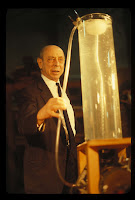When physicist and educator Frank Oppenheimer created The Exploratorium in 1969, little did he know that his highly original prototype would attract over 15 million visitors at the Palace of Fine Arts in San Francisco, generate exhibits that would be played with and enjoyed by more than 180 million people worldwide, and inspire the creation of over 1,000 other experiential museums around the globe.
|
At the crossroads of science and art, the legacy of a great vision lives on at The Exploratorium – a museum for people of all ages that provides educational experiences in science, art, and human perception. http://www.exploratorium.edu/
Today, Executive Director Dr. Dennis Bartels is leading The Exploratorium into the 21st Century with innovative ideas that will take the museum to the next level in an expansive move to the Piers on San Francisco Bay in 2013. With a background in teaching and learning, and a focus on improving math and science education, he is fascinated by how we think, feel, and make decisions about the world around us.
|
Bartels works with researchers, artists, collaborators, and staff to design everything from exhibits to the websites that have over 25,000 pages of content. His vision is to encourage learning by “doing” through hands-on experiences with our environment – for people of all ages.
|
|
Shan: How does The Exploratorium introduce scientific concepts to different age groups using science, art, and perception?
Dennis: The Exploratorium is phenomenon-based. One of my favorite exhibits is Colored Shadows. How can we have different colored shadows? (It really makes you think.) What we discovered is that phenomena are quite universal for all ages. With some of our most fascinating exhibits we have world-renown physicists awed. Physics is the core here. It immediately talks back.
Visit The Exploratorium on YouTube:
|
Shan: What are some of the contributions that have been made to The Exploratorium by the Artists-in-Residence Program?
Dennis: Many artists, both those on staff - including MacArthur "Genius" Fellows - and artists-in-residence, have contributed to a meaningful number of exhibits that you see on the floor of the Exploratorium. Artists sometimes work alone and sometimes collaborate with scientists. We invite people to come and play with us. Scientists and artists have a similar approach. They are “expert noticers” of stuff. They come up with genuine inquiries about the world.
Two classic examples: The Tactile Dome, created by the Dean of the Art Department at San Francisco State University, August Coppola, invites you to find your way with touch. And Sun Painting, created by Bob Miller, captures a sunray through a hole in the roof and using mirrors reflects onto a white wall resulting in a beautiful color spectrum. As a scientist the separation of wavelengths is inspiring. For an artist there is amazement at the incredible variety of a star.
|
Shan: What are some of the innovative online activities offered by the Exploratorium?
Dennis: We were the 600th website on the World Wide Web and one of the first to have “.edu” as part of our url. It’s great what you can experience online without actually visiting The Exploratorium. “What is Evidence: How Do We Know What We Know,” is an Exploratorium website that goes through about 12 ways we look at information. One of my favorite websites is “Ice Stories: Dispatches from Polar Scientists.” We taught a group of scientists how to use video equipment to take with them to the South Pole, so that we could see research in the making.
|
Shan: How will the move to the Piers in 2013 expand upon what the Exploratorium now offers?
Dennis: It allows us to explode – multiply the impact. As an example, there will be a wonderful teaching exhibit. We will finally get to play outdoors with two whole acres. We can use the Bay as our Petrie dish - a story that isn’t told very often. What is more important environmentally, we will have more traffic and can open ourselves up in the evening to adults. Plus, there are so many people that want to play with us – the National Oceanic and Atmospheric Administration, Marine Institute, PIXAR, Stanford University, to name a few. We can now show the cool stuff they are doing.
|
Seeking the curious. The Exploratorium has something for everyone, whether you are an educator, parent, artist, scientist, geek, teen, adolescent, or museum professional.
Visit The Exploratorium on YouTube:
Websites & Online Interactive Activities:
From the oceans to space including Science at Burning Man, Cabspotting, Live Deep-Sea Exploration with the E/V Nautilus, as well as Teacher Institutes and workshops, After School Activities, Food Science, Optical Illusions, Sports Science, Color, and much, much more.
Educators should be sure to check out:
*Artists-in-Residence Program
*Osher Fellowship Program
|
Events:
If you are lucky enough to live in the area, there are monthly events as Family Investigation Workshops, day camps, films, evening art and science events for adults, and professional development opportunities for educators and others. But for those who cannot visit in person there is the Online Media Series, Science In The City, with intriguing explorations of urban environments, natural and human-made phenomena.
Special thanks to Dennis Bartels, Leslie Patterson and Stacy Martin of The Exploratorium for making this blogspot interview possible.
For more information visit http://www.exploratorium.edu/ or http://www.exploratorium.edu/piers/
For general information call (415) 561-0360.
|
Shän Boggs is a writer and editor living in California. Her interests include science, technology, the environment, health, education, multimedia, art, and gourmet cooking. She is the author of a cookbook series for people with food sensitivities.














No comments:
Post a Comment